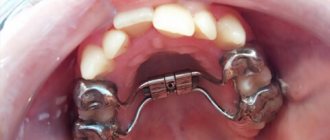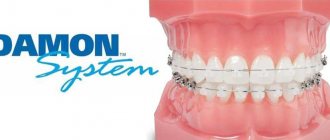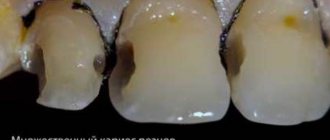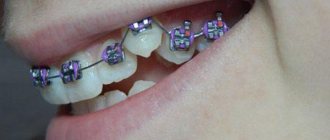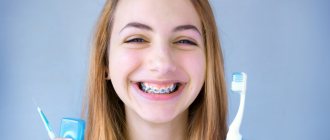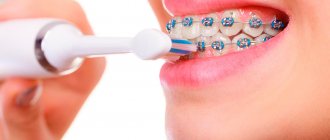Problem: parents contacted a 12-year-old boy. The child's fang is protruding on one side.
Solution: treatment was performed with the Damon brace system. The canine was put in place, the bite was corrected.
Orthodontist consultation
At the consultation, the parents said that previously the fangs had protruded on both sides, but treatment with an orthodontic plate at the local orthodontist put one fang in place, but the second could not be put in place. The treatment with braces with tooth extraction on one side proposed at the district clinic did not appeal to the parents, and they came to the orthodontist at Dial-Dent.
The consultation revealed an incorrect position of the canine, crowded teeth, and incorrect inclination of the front teeth. The distant chewing teeth, the so-called “sevens,” have not yet erupted, so now is the best time to start orthodontic treatment - there is potential for jaw growth, and the treatment will be easier for the child, and the result will be more stable.
The orthodontist spoke about the possibilities of orthodontic treatment, different brace systems and their features, approximate cost and timing. It usually takes about 1.5-2 years to achieve a stable result. No tooth extraction will be required, as modern braces successfully solve problems such as lack of space.
Since the teenager and his parents were serious about orthodontic treatment with braces, the boy was sent for in-depth diagnostics: photometry, OPTG, TRG in the lateral projection, taking impressions of the dentition. A consultation with an osteopath and speech therapist is also recommended, since malocclusion is interconnected both with the position of the head and posture, as well as with the position of the tongue and the correct development of the facial muscles.
Photometry before orthodontic treatment:
Panoramic photo of teeth before treatment:
TRG in lateral projection:
Speech therapist consultation
Speech therapist Tsukor T.B. revealed incorrect position of the tongue, weakness of the tongue muscles, and infantile type of swallowing. A set of exercises for practicing at home is given.
Osteopath consultation
Osteopath An T.Z. Conducted osteopathic diagnostics. Since osteopathic disorders are of a descending type, that is, changes are caused by malocclusion, osteopathic correction is planned throughout the entire orthodontic treatment to adapt the body to the new position of the jaw.
The orthodontist combined the results of research and consultations, made calculations and drew up a treatment plan.
Of the external or internal braces proposed for treatment, the Damon braces system was chosen. To make the teenager less embarrassed about braces, Damon Clear ceramic braces will be installed on the upper teeth, which are almost invisible on the teeth. Metal braces will be installed on the lower teeth, since when communicating, the lower teeth are covered with the lip, and the braces do not attract attention.
Start of orthodontic treatment
Before installing braces on the teeth, a professional teeth cleaning was carried out, as a result of which old plaque was removed, the teeth were polished so that the plaque sticks less, and training was provided in brushing teeth with braces.
Braces are installed on the teeth in two stages for gradual adaptation to new sensations. A starter hygiene kit was issued, which contains everything necessary for caring for teeth with braces, and explains in detail what is intended for what. The starter kit includes orthodontic wax, orthodontic toothbrush, toothpaste, brushes, dental floss, and monobrush. The set was prepared by specialists and is given as a gift when fixing braces.
Damon braces on teeth:
The first arches, which are installed at the beginning of treatment, are made of material that has a memory effect. The doctor bends the arch according to the shape of the dentition, and the arch strives to acquire the original correct shape, thereby changing the position of the teeth. The Damon brace system exerts weak forces on the teeth, but the impact is constant. This combination of constant pressure and gentle forces produces the most consistent orthodontic treatment results.
The structure of the fangs
The canines of the upper jaw are shaped like an irregular cone. The cutting edge is shaped like a triangle, which is limited by three teeth - a pronounced middle one and two outer ones. The area of the tooth facing the lip (vestibular) has a convex shape and gradually approaches the lingual.
On the lingual part of the tooth there is a longitudinal ridge that divides the dental crown into two facets: the lateral part has the largest area. The upper canine has a pronounced crown curvature and root deviation.
The root of the tooth is quite thick and has a shape slightly compressed from the sides. Wider in anteroposterior dimension. The lateral and medial surfaces are very wide and have barely noticeable grooves.
The tooth has one, wide enough and accessible if treatment is necessary, root canal.
The canines located on the lower jaw are smaller in size than the upper ones, and the shape of the crown is close to the upper lateral (side) incisors. They are slightly narrower and longer than the upper canines. The medial surface is in a straight line with the root line. The cutting edge is less pronounced. The distal part of the cutting edge is longer than the medial one.
The labial surface of the lower canines is less convex and pronounced than that of the upper ones, and the lingual surface can be either straight or slightly concave.
The lower fangs have a slightly shorter tooth root than the upper ones, but they have absolutely no differences in shape. In rare cases, anatomical pathology occurs in which the root is divided into two parts.
The canines of both jaws have quite pronounced external differences in the dental crown, but at the same time the dental cavities are very similar.
Orthodontic treatment with braces
Visits to the orthodontist took place every 1.5-2 months. Each time, the orthodontist pays attention to hygiene, monitors the progress of treatment, carries out the manipulations outlined in the treatment plan - changes the arches, adds the necessary elements to the brace system.
The protruding fang fell into place a month after the start of treatment. But the treatment ends only when a stable correct position of all teeth has been achieved and physiological interdental contacts have been created.
While wearing braces, in addition to brushing your teeth twice a day, it is recommended to have your teeth professionally cleaned every six months. This will help remove plaque accumulation in hard-to-reach places (around braces and gums, under arches). Long-term accumulation of plaque leads to demineralization of the enamel and the appearance of white spots on the teeth, which become very noticeable after the braces are removed.
Before brushing your teeth with Air Flow:
After professional teeth cleaning with Air Flow:
To correct the bite, you need to wear orthodontic elastics - elastic rings of different lengths, which are attached to special hooks on braces or arches. The child must secure the oroelastics himself, changing them daily. The orthodontist shows how the elastics are secured and checks whether the patient has understood everything correctly.
It is better for parents to monitor this process, since the duration and result of orthodontic treatment depends on the correct wearing of elastics. You should always have spare elastics with you, since breaks in wearing are extremely undesirable, and if one elastic breaks, both must be changed so that the traction is symmetrical.
After 1 year and 1 month:
The gum has moved away from the tooth: treatment
If the gum has moved away from the tooth, treatment will largely depend on the severity of the inflammation. For example, if a patient seeks help at a fairly early stage of inflammation (when the depth of periodontal pockets does not yet reach 3 mm and there is no tooth mobility), significant success can be achieved in the treatment of periodontitis and the process can be completely stopped. Advanced cases of gum inflammation will require much more complex treatment and serious financial costs. Next we list the main stages of treatment.
1) Consultation and x-ray diagnostics –
It is necessary to begin treatment with a consultation with a periodontist and a panoramic photograph of the teeth, which will allow you to create an optimal treatment plan taking into account the condition of your teeth and gums. The image will allow you to determine the amount of destruction of bone tissue around each tooth, the location and depth of periodontal pockets, and will help guide the patient in the need for splinting of mobile teeth, the need for prosthetic replacement of missing teeth, and make the correct diagnosis.
An example of a panoramic image of a patient with periodontitis –
Looking closely at the image, you may notice that the level of bone tissue (the bone looks in the image as fine-mesh looped tissue and normally should reach the necks of the teeth) is reduced in different teeth by 1/4 to 4/5 of the length of their roots. The patient has decayed teeth that need to be removed, as well as carious teeth that require treatment (24stoma.ru). The level of bone tissue is most reduced in the front teeth of the upper and lower jaw, which in this case was the result of not only inflammation of the gums, but also the absence of the chewing group of teeth.
To treat gums, it is best to contact not ordinary dental therapists or hygienists, but periodontists. These are the dentists who specialize in gum treatment. The first and most important stage of treatment will be ultrasonic teeth cleaning. Next, a course of anti-inflammatory therapy is carried out, which in most cases can be successfully carried out at home.
2) Removal of dental plaque –
First of all, it is necessary to remove the cause of inflammation - microbial plaque and dental deposits. They are removed from the teeth using an ultrasonic scaler (Fig. 15), usually over several visits. It is simply impossible to remove all dental deposits in just 1 visit in a patient with periodontitis, because... It takes a lot of time to remove subgingival dental plaque, which is localized in periodontal pockets below the gum level.
It is subgingival dental plaque that poses the main danger for further progression of inflammation, so sometimes it is necessary to prescribe the patient even 3-5 times. Learn that without professional cleaning, all other stages (for example, anti-inflammatory therapy, splinting) will be completely meaningless.
Most dentists and hygienists won't bother with finding and removing subgingival calculus...as experience has shown. Therefore, it is very important to find a competent specialist. Anti-inflammatory therapy is prescribed immediately after 1 session of removing tartar, and within the first 24 hours you will be able to notice changes in the appearance of the gums. In parallel with the reduction in gum swelling, their volume will also decrease, which will allow you to see new portions of dental plaque and remove them during subsequent visits.
Removing dental plaque with ultrasound: video
You can see in the following photos what happens when subgingival tartar is removed poorly. The first photograph shows that the gums are visually in good condition, although a periodontal probe revealed the presence of a periodontal pocket about 5 mm deep. The second photograph was taken after the gums were detached from the teeth, and it shows a very large amount of destruction of bone tissue, which arose due to the presence of small subgingival tartar on the surface of the tooth root.
3) Anti-inflammatory therapy –
The course of anti-inflammatory therapy usually lasts 10 days. In most cases, it is carried out by the patient himself at home, after doctor’s prescriptions and patient education. However, if the patient has deep periodontal pockets with purulent discharge, the doctor may additionally prescribe washing the periodontal pockets, which is done using a syringe and antiseptic solutions. In some cases, antibiotic therapy may also be prescribed for periodontitis.
Anti-inflammatory treatment regimen - usually a complex is prescribed, consisting of an antiseptic mouth rinse and application of gel to the gums. The procedures are carried out 2 times a day (morning and evening, after meals and subsequent oral hygiene), for 10 days. Most often, a complex of the following drugs is prescribed:
- rinsing with Chlorhexidine (instructions)
- “Cholisal-gel” applications (instructions)
In patients with periodontitis, the correct choice of treatment agents is very important. For example, a standard 0.05% solution of chlorhexidine, sold in pharmacies for 40 rubles, is advisable to use only for superficial inflammation of the gums (gingivitis), but for periodontitis it is better to use a 0.2-0.25% concentration of this antiseptic. It is a big plus when such a solution contains not only a good concentration of chlorhexidine, but also other active ingredients (for example, aluminum lactate for bleeding gums or extracts of medicinal plants).
Antiseptic mouth rinse is carried out after breakfast and oral hygiene, rinse your mouth for 1 minute. After this, the gums need to be dried with a dry gauze pad to remove excess saliva, and an anti-inflammatory gel should be applied to the gum edge. The gel is applied in front of a mirror using a finger, and usually only on the front side of the teeth. After such treatment, it is not recommended to eat for 2-3 hours, and also not to drink for 30 minutes. There are a lot of remedies for treating gums, and we hope that our next articles will help you understand their diversity -
→ The best antiseptics for mouth rinsing, → Rating of the best gels for treating gums.
4) Oral hygiene training –
If you have not yet forgotten the beginning of the article, then remember that the cause of periodontitis and destruction of the dental-gingival attachment is unsatisfactory oral hygiene, which leads to the accumulation of microbial plaque and tartar on the teeth. Therefore, in addition to the basic treatment that we described above, it is very important to constantly maintain high-quality oral hygiene.
Good hygiene doesn't mean just brushing your teeth twice a day, that's not enough. Good oral hygiene includes brushing your teeth after every meal, not snacking on cookies or candy between meals, and regularly using dental floss. You can read about absolutely all the recommendations in the article at the link above. Below, you can watch the video on how to properly use a toothbrush and dental floss.
How to use dental floss and brush correctly -
In the presence of periodontal pockets and mobile gingival margins, it is important to carry out hygiene below the gum level. This can be done using special devices - home irrigators. Special attachments allow you to rinse at home not only areas of the oral cavity that are difficult to reach for hygiene, but also periodontal pockets below the level of the gingival margin. Irrigators can use both ordinary boiled water and special medicinal solutions.
